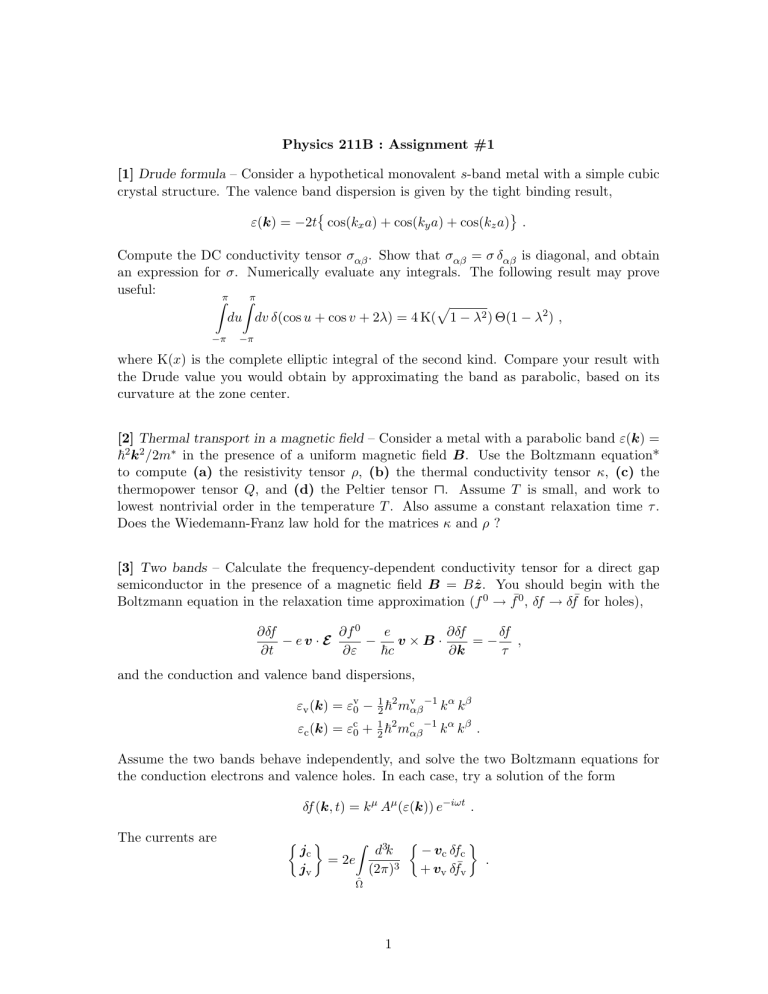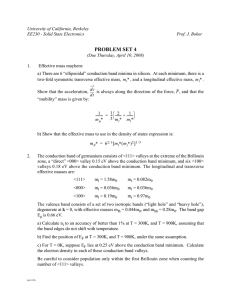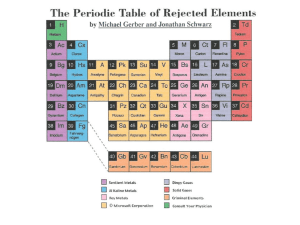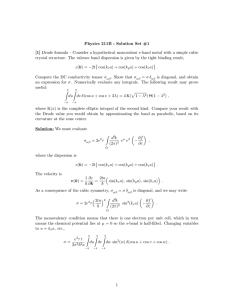Physics 211B : Assignment #1

Physics 211B : Assignment #1
[1] Drude formula – Consider a hypothetical monovalent s -band metal with a simple cubic crystal structure. The valence band dispersion is given by the tight binding result,
ε ( k ) = − 2 t cos( k x a ) + cos( k y a ) + cos( k z a ) .
Compute the DC conductivity tensor σ
αβ
. Show that σ
αβ
= σ δ
αβ is diagonal, and obtain an expression for σ . Numerically evaluate any integrals. The following result may prove useful:
Z
π du
Z
π dv δ (cos u + cos v + 2 λ ) = 4 K( p
1 − λ 2 ) Θ(1 − λ
2
) ,
− π − π where K( x ) is the complete elliptic integral of the second kind. Compare your result with the Drude value you would obtain by approximating the band as parabolic, based on its curvature at the zone center.
[2] Thermal transport in a magnetic field – Consider a metal with a parabolic band ε ( k ) =
~
2 k 2 / 2 m
∗ in the presence of a uniform magnetic field B . Use the Boltzmann equation* to compute (a) the resistivity tensor ρ , (b) the thermal conductivity tensor κ , (c) the thermopower tensor Q , and (d) the Peltier tensor u . Assume T is small, and work to lowest nontrivial order in the temperature T . Also assume a constant relaxation time τ .
Does the Wiedemann-Franz law hold for the matrices κ and ρ ?
[3] Two bands – Calculate the frequency-dependent conductivity tensor for a direct gap semiconductor in the presence of a magnetic field B = B ˆ . You should begin with the
Boltzmann equation in the relaxation time approximation ( f
0 → f
¯ 0
, δf → δ f
¯ for holes),
∂δf
− e v · E
∂t
∂f
0
∂ε e
−
~ c v × B ·
∂δf
∂ k
= −
δf
τ
, and the conduction and valence band dispersions,
ε v
( k ) = ε v
0
ε c
( k ) = ε c
0
−
+
1
2
~
2 m v
αβ
− 1
1
2
~
2 m c
αβ
− 1 k
α k
β k
α k
β
.
Assume the two bands behave independently, and solve the two Boltzmann equations for the conduction electrons and valence holes. In each case, try a solution of the form
δf ( k , t ) = k
µ
A
µ
( ε ( k )) e
− iωt
.
The currents are j c j v
= 2 e
Z d
3 k
(2 π ) 3
− v c
+ v v
δf c
δ f
¯ v
.
1
Compute σ
αβ and m c along principal axes of the effective mass tensors. You may assume that commute, i.e.
they have the same eigenvectors. You should further assume that m v
B lies along a principal axis.
[4] Spin disorder resistivity (for the brave only!) – Consider an isolated trivalent Tb impurity ion in a crystal field. Application of Hund’s rules gives a total angular momentum
J = 6. A cubic crystal field splits this 13-fold degenerate multiplet into six levels: two singlets, one doublet, and three triplets. The ground state is a singlet. Using the first Born approximation, calculate the temperature-dependent resistivity in a free electron model with a scattering Hamiltonian
H imp
= − A ( g − 1)
N imp
X
δ ( r − R j
) S · J j
/
~
2 j =1
, where r and S are the conduction electron position and spin operators R j and J j are the impurity position and angular momentum of the j th
Tb impurity.
A is the strength of the exchange interaction, and g =
3
2 is the gyromagnetic factor.
(a) In general the relaxation time is energy-dependent: τ = τ ( ε ). Show that the resistivity is given by ρ = m/ne
2 h τ i , where the average is with respect to the weighting function
ε g ( ε ) ( − ∂f
0
/∂ε ). Show also that
1
≤ h τ
− 1 i , h τ i which provides an upper bound for ρ which can often be computed.
(b) Use the results of (a) to derive the approximate expression for the resistivity ρ '
ρ
0 p ij
Q ji
, where p ij
Q ij
=
= e
− E i
/k
B
T
1
2
P k e
− E k
/k
B
T i J
+ j
2
·
( E i
− E i
) /k
B
T
1 − e
− ( E i
− E j
) /k
B
T
+
1
2 i J
− j
2
+ i J z j
2
, where the ionic energy levels are denoted by E i
(2 J + 1) crystal field states. Show that and where the summations run over the
ρ
0
=
3 πm ( g − 1)
2
A
2 n imp
8 e 2
~
3 ε
F
.
(c) Show that the high temperature limiting value of ρ is J ( J + 1) ρ
0 the spin-disorder resistivity.
. This is often called
[5] Cyclotron resonance in Si and Ge – Both Si and Ge are indirect gap semiconductors with anisotropic conduction band minima and doubly degenerate valence band maxima. In
2
Si, the conduction band minima occur along the h 100 i ( h ΓX i ) directions, and are six-fold degenerate. The equal energy surfaces are cigar-shaped, and the effective mass along the h ΓX i principal axes (the ‘longitudinal’ effective mass) is m
∗ l
' 1 .
0 m e
, while the effective mass in the plane perpendicular to this axis (the ‘transverse’ effective mass) is m
∗ t
' 0 .
20 m e
.
The valence band maximum occurs at the unique Γ point, and there are two isotropic hole branches: a ‘heavy’ hole with m
∗ hh
' 0 .
49 m e
, and a ‘light’ hole with m
∗ lh
' 0 .
16 m e
.
In Ge, the conduction band minima occur at the fourfold degenerate L point (along the eight h 111 i directions) with effective masses m
∗ l band maximum again occurs at the Γ point, where the hole masses are m
∗ hh m
∗ lh
' 0 .
044 m e
' 1 .
6 m e and m
∗ t
' 0 .
08 m e
. The valence
' 0 .
34 m e and
. Use the following figures to interpret the cyclotron resonance data shown below. Verify whether the data corroborate the quoted values of the effective masses in Si and Ge.
Figure 1: Constant energy surfaces near the conduction band minima in silicon. There are six symmetry-related ellipsoidal pockets whose long axes run along the h 100 i directions.
Figure 2: Cyclotron resonance data in Si (G. Dresselhaus et al.
, Phys, Rev, 98 , 368 (1955).)
The field lies in a (110) plane and makes an angle of 30
◦ with the [001] axis.
3
Figure 3: Constant energy surfaces near the conduction band minima in germanium. There are eight symmetry-related half-ellipsoids whose long axes run along the h 111 i directions, and are centered on the midpoints of the hexagonal zone faces. With a suitable choice of primitive cell in k -space, these can be represented as four ellipsoids, the half-ellipsoids on opposite faces being joined together by translations through suitable reciprocal lattice vectors.
Figure 4: Cyclotron resonance data in Ge (G. Dresselhaus et al.
, Phys, Rev, 98 , 368 (1955).)
The field lies in a (110) plane and makes an angle of 60
◦ with the [001] axis.
4









